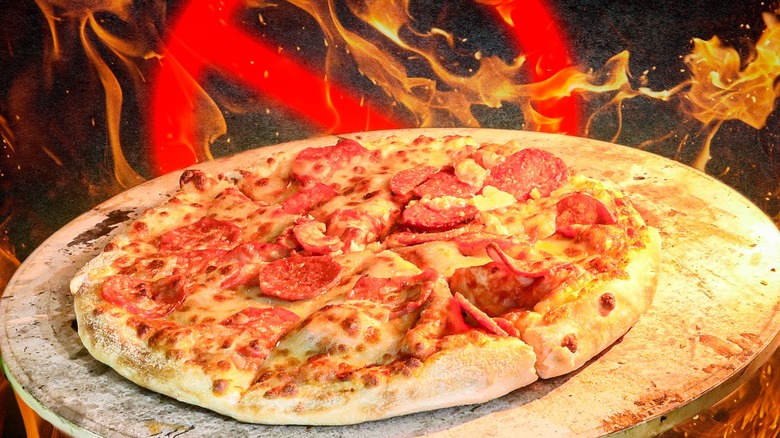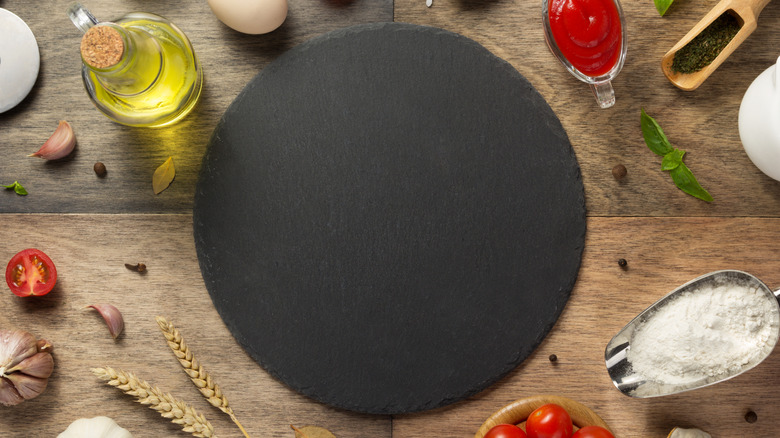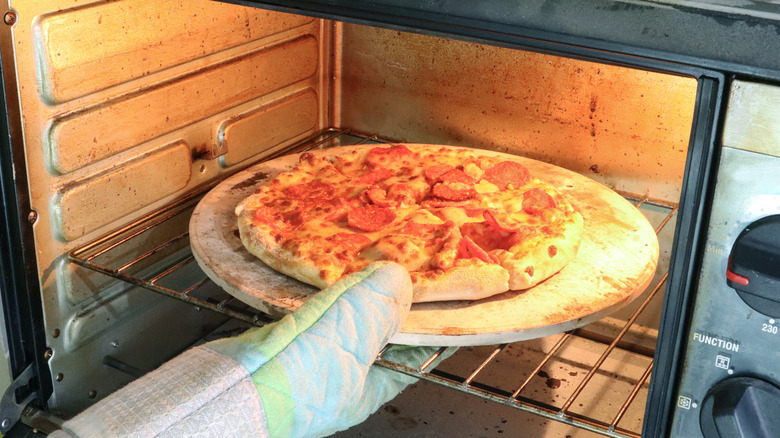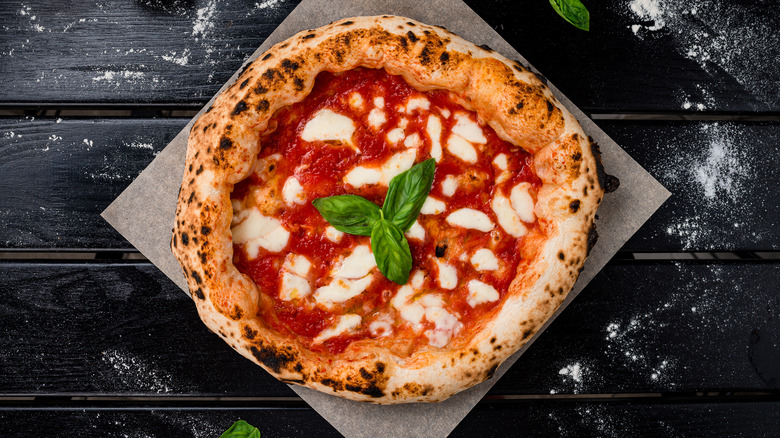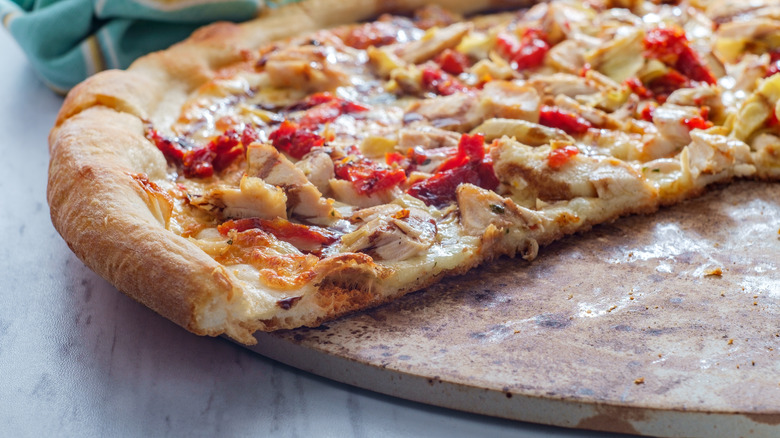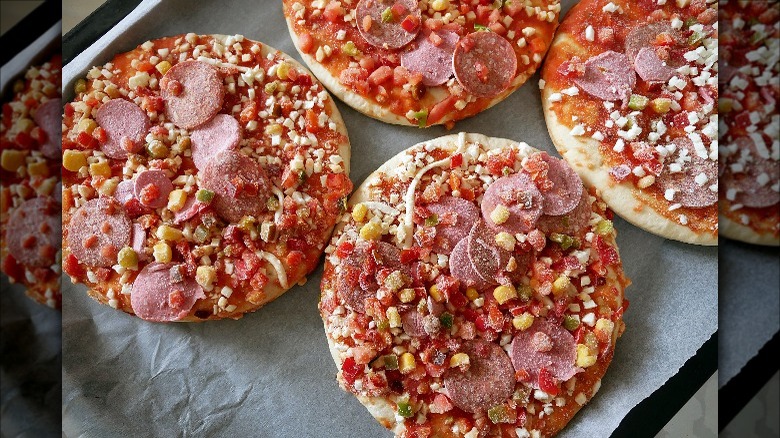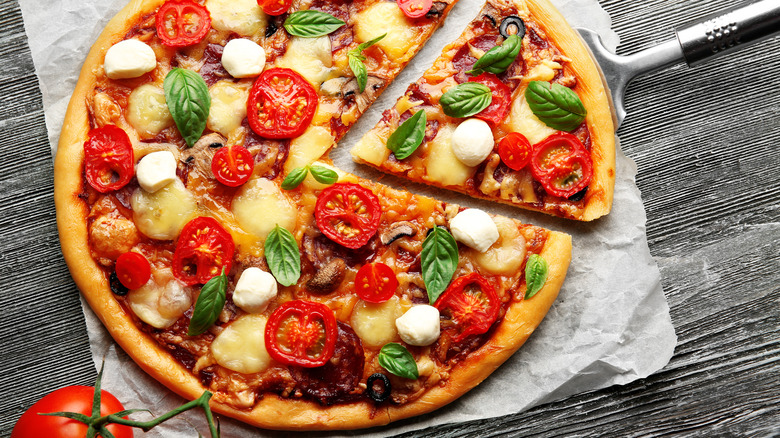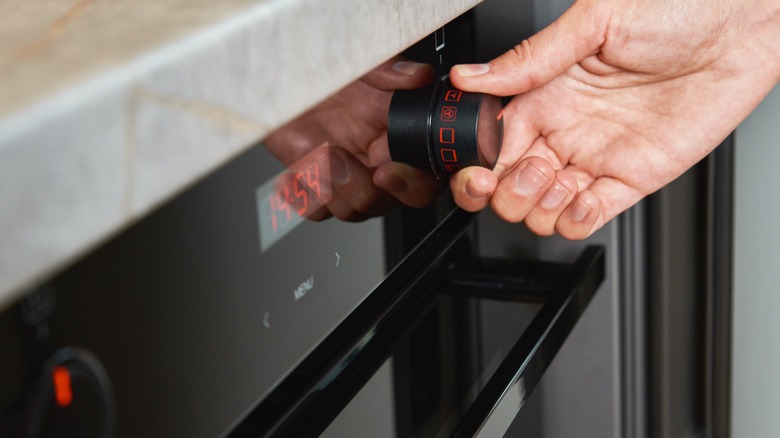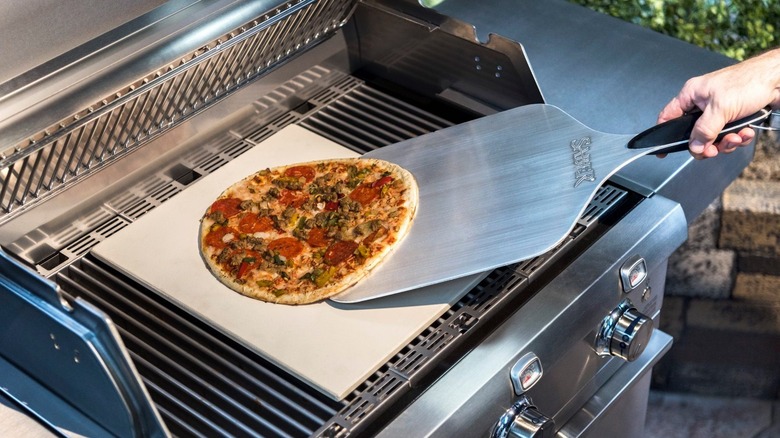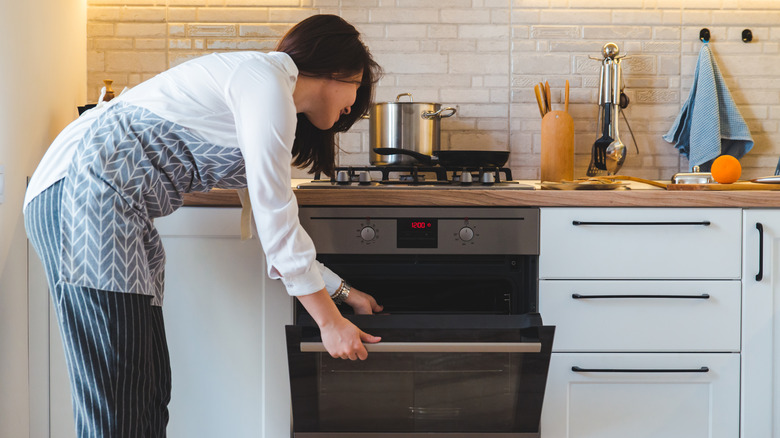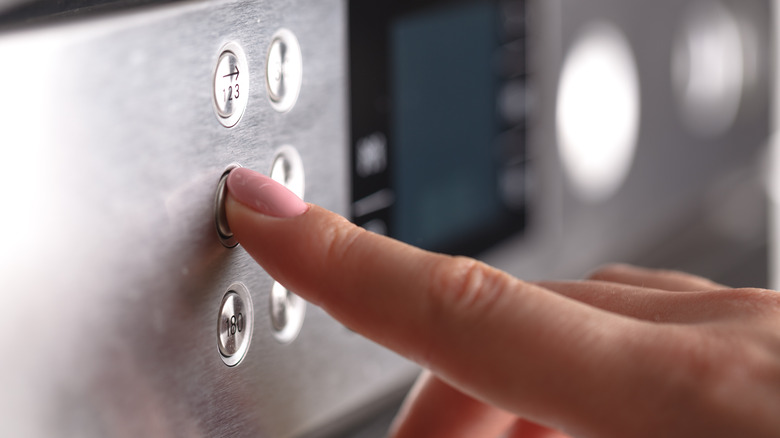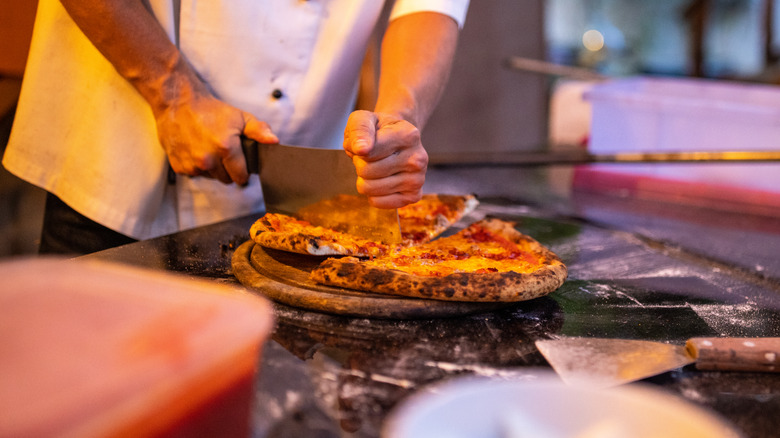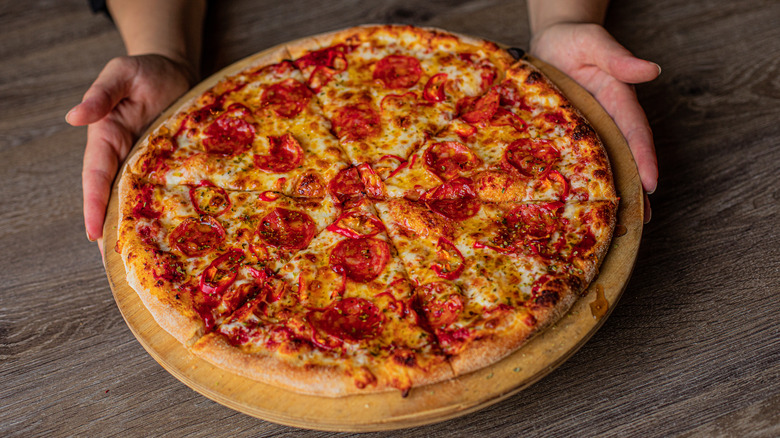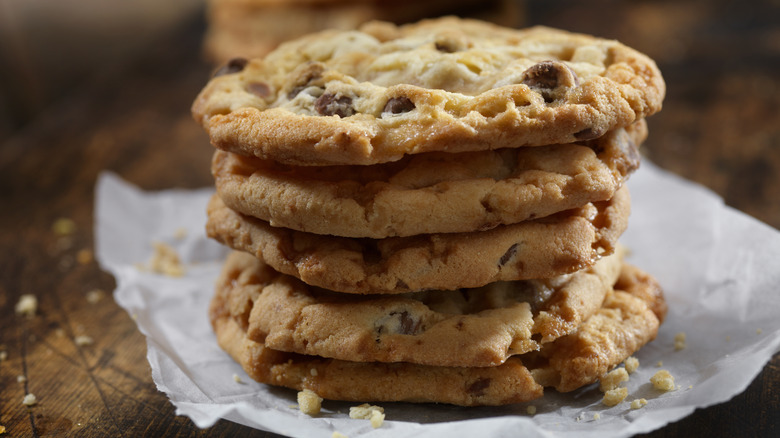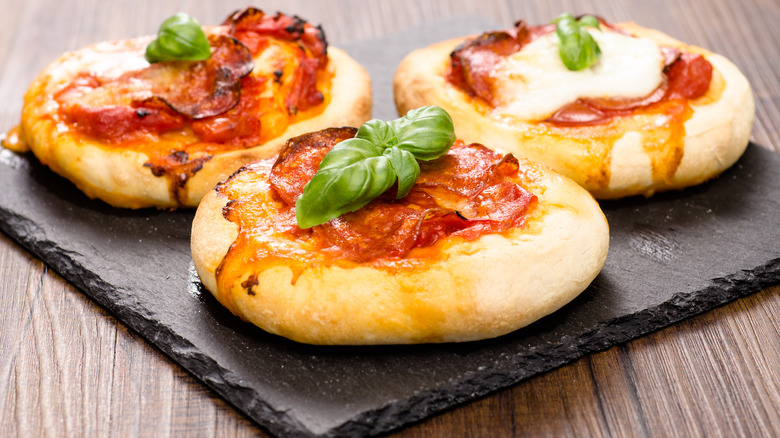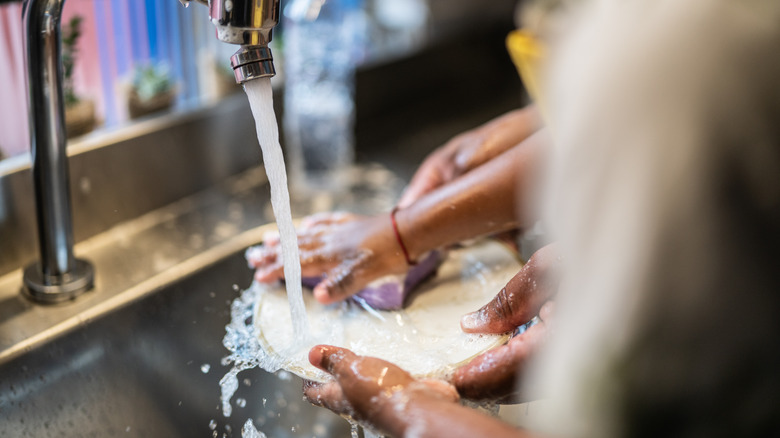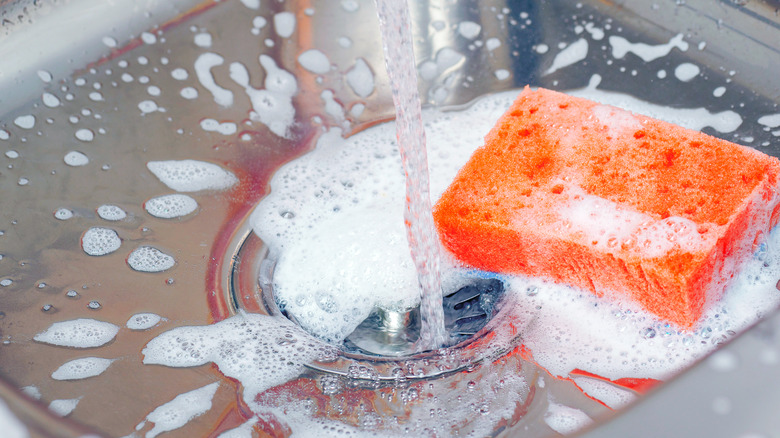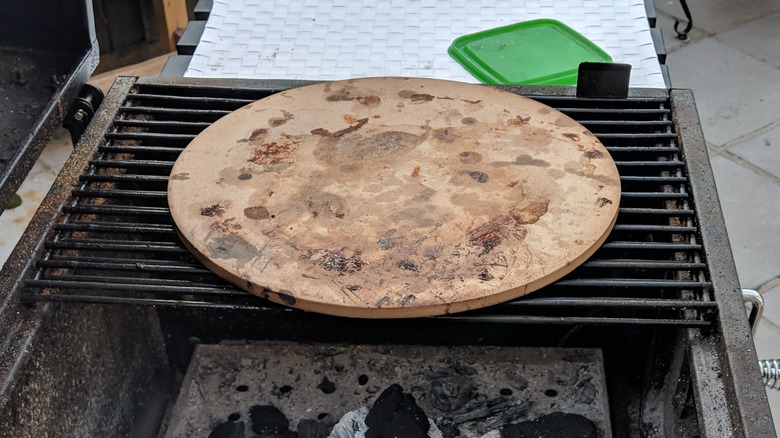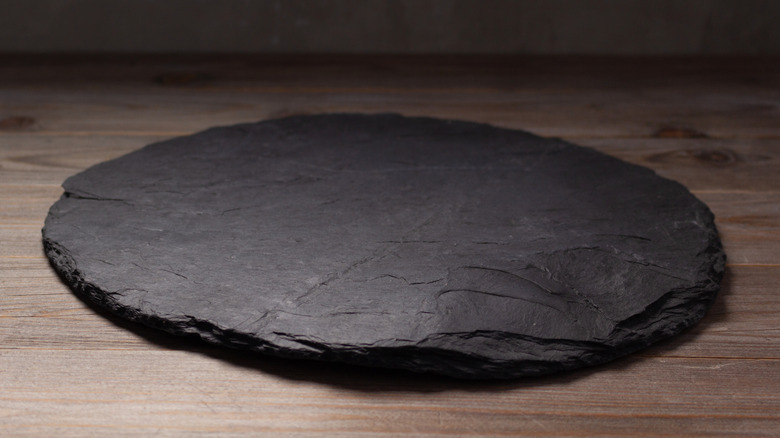18 Mistakes You Need To Stop Making With Your Pizza Stone
It is possible to make delicious, restaurant-quality pizza at home — even without a brick oven. As with any hobby or practice, you need the best tools for the best outcome, and pizza is no exception. Using a pizza stone can help you make a pie with a perfect crust and evenly cooked toppings.
When used correctly, a pizza stone takes in excess moisture, makes for a crispier base, and distributes the heat more evenly across your pie. That also means it retains the heat and cools down your pizza in a slow and steady manner, so you have time to enjoy every slice.
While it might seem like the simplest thing, popping stone in your oven can go awry if you fail to avoid certain mistakes. When used incorrectly, it can result in a cracked or damaged stone, a pizza that doesn't turn out as expected, and other catastrophes.
1. Oiling the stone
If you are used to cooking on cast iron, you might assume that you should oil your pizza stone to season it. However, doing so will almost always be a mistake. Most pizza stone manufacturers recommend against it because stones are porous.
That means if you try to season them with oil before baking, some of the oil will soak into the pores. This can lead to the stone smoking in the oven, and in some cases, the oil may become rancid sitting in the pores. So, we recommend saving this for another recipe that requires a different tool.
2. Putting a cool pizza stone into a hot oven
Putting a cold, or even room temperature, pizza stone into a hot oven is one of the biggest mistakes you can make. You should always make sure that the oven is off — and also cool — before putting the stone into it. When stones go from one extreme temperature to another, it can cause thermal shock.
Thermal shock will essentially cause the pizza stone to crack. If that does happen, you will have a big mess to clean up in your oven and risk getting injured on a sharp piece of stone while cleaning up.
3. Not preheating the stone
Preheating a pizza stone is an important step that is often overlooked. When you put your pizza on a cool stone, it won't bake as quickly. This means that the crust may end up undercooked and mushy. Conversely, if the stone is hot, it will be able to pass more of the heat to the pizza crust, allowing it to cook quickly and get nice and crispy.
To preheat your oven properly, make sure you set aside enough time for it to get hot — this may take up to 45 minutes or 1 hour. Set your oven to a minimum of 500 degrees Fahrenheit or higher. In this case, the more heat you can generate, the better your pizza will come out.
4. Removing the stone from the oven to let it cool
Another mistake you might be making is taking the stone out of the oven to cool. When you remove the stone from a hot oven and place it on a trivet or your stovetop, it will experience a rather extreme change in temperatures.
Think about it, you're likely baking the pizza at temperatures over 500 degrees Fahrenheit in the oven, then moving the stone to your kitchen countertops where the air is somewhere between 68 and 76 degrees Fahrenheit. This drastic temperature change will cause thermal shock, which you probably know by now is not a good thing.
So, instead of taking your stone out of the oven to cool, turn off the heat and let it cool inside. The oven temperature will decrease much more gradually, protecting the stone against cracking or other damage.
5. Cooking your frozen pizzas on it
Yet another fairly common mistake people make with their pizza stones is baking a frozen pizza on it. Placing a frozen pizza on a ceramic stone to bake inside a hot oven will most likely lead to cracking and damage.
The extreme temperature change poses all the risks of thermal shock here. So, we recommend saving your stone for homemade pizza. And instead of baking frozen pizzas on a stone, place them on a metal baking pan or directly on the oven rack. In this case, it's probably better to be safe than sorry.
6. Using parchment paper on the stone
Many people like baking on parchment paper since it can help keep food from sticking to the pan, makes it easier to transfer items on and off of a baking sheet, and simplifies clean up. However, even if you traditionally like baking this way, you'll want to avoid using parchment paper on your pizza stone.
Since you'll most likely be baking your pizzas in a very hot oven — typically 500 degrees Fahrenheit or hotter — the parchment paper may burn. Typically, this paper is not suited for ovens or baking that is hotter than 430 degrees. Instead, we recommend getting a pizza peel if you're looking for an easy way to transfer your pizza.
7. Not cooking at the ideal temperature
If you want the pizzas you make on your stone to turn out the best, setting the oven to the right temperature is important. A temperature that is too low isn't going to allow the crust to get nice and crispy. Hotter temperatures will distribute the heat throughout the entire crust, helping it cook quickly and crisp up beautifully.
To achieve these results, try to bake in an oven set to about 550 degrees Fahrenheit. However, always check for the manufacturer's instructions, as some don't recommend using their stones in ovens that are this hot.
8. Not realizing that you may also be able to use it on the grill
Did you know that you might even be able to use your pizza stone on the grill? If not, then you've missed a whole world of possibilities. When you cook pizza on a stone over the grill, you combine all the benefits of stoneware with the benefits of grilling food.
Not only will the pizza crust be crispy and delicious, but the pizza will also pick up some of that nice smoky flavor that is only possible when cooking on a grill. However, some manufacturers specifically state that their stones should not be used over the direct heat of a grill. So, before attempting to grill a pizza on your stone, be sure to check the use and care instructions.
9. Storing it somewhere other than in the oven
We've mentioned that the best way to let a stone cool down is in the oven. The oven can also be the best place to store your stoneware. When you store your stone in the oven, you can help prevent exposing it to extreme temperature changes, as it will always be gradually heating up or cooling down along with the oven itself.
Keeping your pizza stone in the oven can also benefit cooking other foods. The stone will help ensure the heat is evenly distributed throughout the oven. This can also help your foods cook more evenly — whether they're actually baking on the stone or on another pan.
10. Leaving the stone in the oven during a self-cleaning cycle
If you do decide to store your pizza stone in the oven, there are some times that you'll need to remember to take it out. One of these is when you're using a self-cleaning cycle to clean your oven. Self-cleaning cycles are not meant to clean anything other than the inside of an oven.
They utilize very high temperatures — much higher than anything you'd use for baking — to burn off the residue on the walls or bottom of the oven. Leaving your pizza stone in the oven, whether intentionally or unintentionally, during a self-cleaning cycle will likely cause it to crack.
11. Cutting directly on the stone
After removing your pizza from the oven, do not cut it directly on the pizza stone. Cutting directly on the stone — either with a knife or a pizza cutter — can cause big problems. The sharp knife or pizza peeler may scratch the stone, damage its surface, or potentially dull the cutting edge of your knife or peeler.
It is best to transfer the pizza to a cutting board before slicing it. To remove your pizza from the stone without damaging it, consider using a pizza peel. Another benefit of cutting the pizza on a separate surface is leaving your pizza stone in the oven to cool down — which will help protect it against thermal shock.
12. Thinking all pizza stones are the same
Not all pizza stones are going to cook your pie the same. Stones are actually made using a variety of different materials. Each of these materials can impact the cooking performance of the stone and how long it is likely to last. Generally speaking, thicker stones are better at retaining heat, which is important for ensuring that a pizza will bake quickly.
Beyond the thickness of the stone itself, also note the material, as it will impact how heat is conducted. Most pizza stones are made from ceramic as it conducts heat well, cooks pizza evenly, and is the most reasonably priced. If you're willing to spend a little more money, you might want to consider a cordierite pizza stone. Cordierite is very durable and is even resistant to thermal shock.
Some products marketed as pizza stones are actually made from steel. Pizza or baking steels can also be used at higher oven temperatures than true stones. However, they are not able to conduct heat as evenly as their stone counterparts.
13. Only making pizza on it
Despite its name, pizza stones can — and should — be used for more than just making pizza. Their ability to retain heat and evenly distribute it across the entire cooking surface can help you create delicious main dishes, side dishes, snacks, and even some desserts.
One of the best things to cook on a pizza stone is cookies. You'll find that they bake so much more evenly and turn out perfectly crispy. Just be prepared to add a little extra time to what is listed in the recipe.
Roasting vegetables on a stone is another idea you'll have to try. You'll be impressed with how tender yet crunchy the finished veggies turn out. Before baking them, you'll want to toss them with some oil, salt, and any other desired seasonings. Beyond cookies and veggies, you can also use your stoneware to cook chicken, pork chops, fish, and other meats.
14. Not realizing that round stones aren't the only option
What shape is your pizza stone? Is it round? Did you know that you can find stones in other shapes as well? While a round stone may be the best option for making pizza — unless you prefer a rectangular pizza — a different shape may be better for other recipes.
For example, if you want to use your stone for making cookies, roasting vegetables, or cooking meat, as previously suggested, a rectangle shape may be best — perhaps even one with a lip to keep small veggies or juices from meat from dripping off. A narrower rectangle may also fit better on your grill. We recommend a rectangular or more square shape stone for the most diverse uses.
15. Washing your stone before it cools completely
We've talked a lot about thermal shock, but here is another mistake that could result in a cracked stone. Never wash a hot stone. It is essential to let it cool all the way down before trying to clean it. Otherwise, the cooler water from the faucet can cause the hot stone to crack.
Moreover, you may end up burning yourself if you try to clean a hot stone. Because they retain heat so well, stones will stay hotter longer than metal bakeware. Give your stone plenty of time to cool down in the oven, and only remove it to clean once you're certain it has cooled down all the way.
16. Cleaning it with soap or submerging it under water
Since pizza stones are porous, they will absorb moisture and flavors. For this reason, you need to take extra care when cleaning them. One mistake you can make when cleaning a pizza stone is using soap. The stone will absorb some of the soap, and the next time you make a pizza, it might end up tasting soapy.
If you or someone else cleans your stone with soap by mistake, don't panic. You should be able to prevent the soap from ruining the flavor of your next pizza by unrolling crescent roll dough over the stone and baking it. Simply toss out the finished dough — along with the absorbed soapy taste — to give your stone a reset before the next time you need to use it.
Similarly, it is not a good idea to submerge your stone in water. Even if the water isn't soapy, the pores can still absorb some water. The next time you bake a pizza on the stone, the excess moisture in the pores could alter the crust's texture and prevent it from crisping up as desired.
17. Not knowing how to deep clean a pizza stone to remove grease stains
While you don't want to use soap to clean your pizza stone, that doesn't mean you are left without any options for removing grease on the surface. In most cases, stains or spots on a pizza stone are just a sign of love and will not have any negative impact on how foods cook.
However, if there is a particularly greasy stain that you want to remove, you can deep clean the stone using a paste made from baking soda and water. Combine the two ingredients in equal parts and use a kitchen brush to scrub the mixture over the grease stains. For particularly greasy spots, you might want to let the paste sit for a few minutes before scrubbing.
18. Thinking a dark pizza stone is trash
After several uses, your pizza stone will not look as pristine as it did when it was new. However, don't interpret this as a sign that the stone needs to be replaced. In fact, quite the opposite is true.
The darkening color is part of the natural process of using the stone and will not impact how foods cook on it. In some cases, you may even find the stone becoming even more nonstick as it darkens. If your stone looks dark, see it as a sign that it is well-loved, not that it is time to look for a replacement. With proper care, you should be able to get several years of use out of your stoneware.
